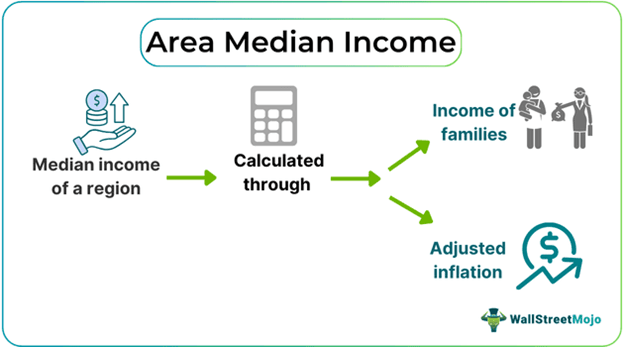Table of Contents
What Is Area Median Income (AMI)?
Area median income is a metric that measures a specific area's income distribution's median point. The Department of Housing and Urban Development measures it on an annual basis. The metric reveals the affordable housing rates for each county or multi-county metro area.

The metric estimates the income limits for program eligibility and calculates affordable rents in certain cases for local and federal programs. Housing and urban development and other agencies use the metric to decide who will receive subsidized housing facilities and how much they will pay in rent.
Key Takeaways
- Area median income is a metric used by federal and local agencies to determine eligibility for affordable housing programs.
- It reveals the middle household income of a specific region and the need for housing programs in the area.
- It is calculated using family income taken from the American community survey after adjusting for inflation.
- The government considers units that cost less than 30% of household incomes in a region to determine affordable household units.
- AMI is useful in determining income limits, providing veterans with disability income support, and in financial planning. Some federal home loan banks use them to estimate funding properties.
Area Median Income Explained
Area median income, or AMI, is the central static metric used by agencies to determine the eligibility factor for affordable housing programs. It reveals the median household income for the region. The HUD, or the Housing and Urban Development, estimates the median income of regions rather than just cities. The calculation is done for fair market rent or FMR area. It is also referred to as the median family income or the MFI.
The median income of regions is used to benchmark incomes and emphasize the need for housing programs in the area. The income benchmarks are estimated and adjusted based on household or family size. The income limits and guidelines are evaluated using the American Community Survey or the ASC. The AMI is important as it helps determine eligibility for programs and design them.
The household income is compared to the AMIs of local areas as a percentage to evaluate eligibility. According to the government, affordable housing units are categorized only if they cost less than 30% of the household income in a region. The Housing Act of 1937 introduced the AMI into the federal housing policy. This is the act that institutionalized public housing.
How To Calculate?
The calculation of AMI involves two main components: the median family income and inflation adjustments. After the median family income and inflation are calculated and adjusted, the estimated value is rounded to the nearest 100 dollars. The median family income is estimated from the most recently available data from the ACS or the American Community Survey of the Census Bureau.
Family income includes income received consistently before the personal income tax and other payments received in the past 12 months. These payments include union dues, social security, and Medicare deductions. Since there are often lags between the ACS data collection and release, the current year's income has to be inflation-adjusted.
Examples
Let us look at some of the examples to understand the concept better.
Example #1
Imagine Dan is an individual who wants to avail of a federal home loan rental program and searches for area median income by zip code. He has a household income of $10000 in XYZ County. His income falls in the 50% percent category, and he is ready to check with an area median income calculator. Suppose the County has an income threshold of $80000. 50% of $80000 is $40000, and Dan's income is $10000, which can be estimated without the use of an area median income calculator. The Federal Housing Finance Agency has categorized the income of $10000 under the category of very low-income limit. Dan, hence, is eligible to avail of the home loan rental program.
Example #2
The AMI data in Minnesota for the year 2024 show the statistics of various household income groups from various counties. The data is divided by county, income threshold, and household size, which ranges from 1 to 8. To determine the affordable rates in the region, a person has to look at the county name and the household median income. For example, a person looking for eligibility to avail of housing programs from Dakota with a 4-member household has to look at the values.
The Dakota County median value is at $97800 for 80%AMI, and for 150% AMI, it is $186300. Those that fall below the income of $97800 are eligible for federal affordable housing programs.
Importance
Given below are some of the points that highlight the importance of AMIs
- It helps in setting income limits for the determination of eligibility for housing programs. Local, state, and national housing finance programs use it.
- The US Department of Treasury uses it to set income and rent limits. This is done for programs financed through low-income housing tax credits (LIHTC) and tax-exempt housing bonds.
- It is used for financial planning and service provision by affordable housing developers and local housing agencies.
- Affordable housing property owners also use them for financial planning.
- The AMIs, once set, are used to decide the geographical regions that are eligible for specific grant programs.
- It is used to set rents for affordable housing programs and other rules or requirements.
- Federal home loan banks use the AMIs to determine rental program funding priorities and homeownership funding priorities.
- The US department of veteran's affairs use them to determine the eligibility of veterans who require disability income support.
- Some of the federal agencies and local ones use AMIs as an alternative to the federal poverty rates. It helps them determine the economic conditions of the region for granting purposes.
- AMIs are also used in programs that incentivize new construction in the community and support new home buyers.
